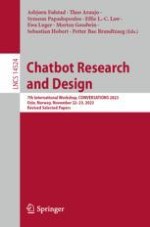2024 | Buch
Chatbot Research and Design
7th International Workshop, CONVERSATIONS 2023, Oslo, Norway, November 22–23, 2023, Revised Selected Papers
herausgegeben von: Asbjørn Følstad, Theo Araujo, Symeon Papadopoulos, Effie L.-C. Law, Ewa Luger, Morten Goodwin, Sebastian Hobert, Petter Bae Brandtzaeg
Verlag: Springer Nature Switzerland
Buchreihe : Lecture Notes in Computer Science
